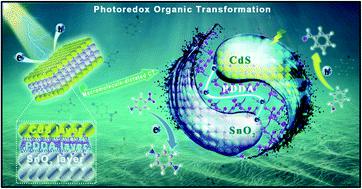当前位置:
X-MOL 学术
›
J. Mater. Chem. A
›
论文详情
Our official English website, www.x-mol.net, welcomes your
feedback! (Note: you will need to create a separate account there.)
Modulating charge migration in photoredox organic transformation via exquisite interface engineering
Journal of Materials Chemistry A ( IF 10.7 ) Pub Date : 2020-04-02 , DOI: 10.1039/d0ta02122a Shuai Xu 1, 2, 3, 4 , Ming-Hui Huang 1, 2, 3, 4 , Tao Li 1, 2, 3, 4 , Zhi-Quan Wei 1, 2, 3, 4 , Xin Lin 1, 2, 3, 4 , Xiao-Cheng Dai 1, 2, 3, 4 , Shuo Hou 1, 2, 3, 4 , Xiao-Yan Fu 1, 2, 3, 4 , Fang-Xing Xiao 1, 2, 3, 4
Journal of Materials Chemistry A ( IF 10.7 ) Pub Date : 2020-04-02 , DOI: 10.1039/d0ta02122a Shuai Xu 1, 2, 3, 4 , Ming-Hui Huang 1, 2, 3, 4 , Tao Li 1, 2, 3, 4 , Zhi-Quan Wei 1, 2, 3, 4 , Xin Lin 1, 2, 3, 4 , Xiao-Cheng Dai 1, 2, 3, 4 , Shuo Hou 1, 2, 3, 4 , Xiao-Yan Fu 1, 2, 3, 4 , Fang-Xing Xiao 1, 2, 3, 4
Affiliation

|
Modulating photo-induced charge separation/transfer constitutes a central challenge in heterogeneous photocatalysis. Despite advancements in this area, finely tuning directional electron migration without involving conventional co-catalysts [e.g., metal nanocrystals and transition metal dichalcogenides (TMDs)] for boosted photoredox catalysis has not yet been explored. Herein, we report the exquisite design of a novel and general macromolecule-modulated photoredox selective organic transformation system, wherein an ultrathin macromolecular poly(diallyldimethylammonium chloride) (PDDA) layer was integrated at the interface of wide-band-gap (WBG) and narrow-band-gap (NBG) semiconductors to construct heterostructured photocatalysts. The ultra-thin PDDA interim layer expedites interfacial unidirectional electron transfer from the NBG to WBG semiconductor, resulting in a cascade electron transfer channel. The favorable energy level alignment among the building blocks, intimate interfacial integration and multilayered nanoarchitecture endow the WBG@PDDA@NBG heterostructures with substantially enhanced and versatile photoredox performance toward the selective oxidation of aromatic alcohols to aldehydes and the anaerobic reduction of nitroaromatics to amino compounds under visible light irradiation. This can be ascribed to the crucial role of the ultrathin intermediate PDDA layer as a highly efficient metal and TMD-free charge transfer mediator, relaying the electrons from the NBG to WBG semiconductor and slowing charge recombination. Our work could open up new frontiers to exploit diverse metal and TMD-free photocatalytic systems and provide a first insight into the fine tuning of charge transport utilizing non-conductive ionic polymers for solar energy conversion.
中文翻译:

通过精美的界面工程调节光氧化还原有机转化中的电荷迁移
调节光诱导的电荷分离/转移构成了非均相光催化的主要挑战。尽管在这一领域取得了进步,但在不涉及常规助催化剂的情况下,可以精细地调节方向电子迁移[例如,金属纳米晶体和过渡金属二卤化物(TMDs)]用于增强光氧化还原催化作用尚未探索。在此,我们报告了一种新颖且通用的大分子调制的光氧化还原选择性有机转化系统的精巧设计,其中超薄大分子聚二烯丙基二甲基氯化铵(PDDA)层集成在宽带隙(WBG)和窄界面之间带隙(NBG)半导体以构造异质结构光催化剂。超薄PDDA过渡层可加速从NBG到WBG半导体的界面单向电子转移,从而形成级联电子转移通道。各个构件之间的有利能级对齐,紧密的界面结合和多层纳米结构赋予WBG @ PDDA @ NBG异质结构显着增强的通用光氧化还原性能,可在可见光照射下将芳族醇选择性氧化为醛,并将硝基芳族化合物厌氧还原为氨基化合物。这可以归因于超薄中间PDDA层作为高效金属和无TMD电荷转移介体,将电子从NBG中继到WBG半导体并减缓电荷复合的关键作用。我们的工作可能会开拓新的领域,以开发各种不含金属和TMD的光催化系统,并为利用非导电性离子聚合物进行太阳能转化的电荷传输的精细调节提供第一见解。
更新日期:2020-04-24
中文翻译:

通过精美的界面工程调节光氧化还原有机转化中的电荷迁移
调节光诱导的电荷分离/转移构成了非均相光催化的主要挑战。尽管在这一领域取得了进步,但在不涉及常规助催化剂的情况下,可以精细地调节方向电子迁移[例如,金属纳米晶体和过渡金属二卤化物(TMDs)]用于增强光氧化还原催化作用尚未探索。在此,我们报告了一种新颖且通用的大分子调制的光氧化还原选择性有机转化系统的精巧设计,其中超薄大分子聚二烯丙基二甲基氯化铵(PDDA)层集成在宽带隙(WBG)和窄界面之间带隙(NBG)半导体以构造异质结构光催化剂。超薄PDDA过渡层可加速从NBG到WBG半导体的界面单向电子转移,从而形成级联电子转移通道。各个构件之间的有利能级对齐,紧密的界面结合和多层纳米结构赋予WBG @ PDDA @ NBG异质结构显着增强的通用光氧化还原性能,可在可见光照射下将芳族醇选择性氧化为醛,并将硝基芳族化合物厌氧还原为氨基化合物。这可以归因于超薄中间PDDA层作为高效金属和无TMD电荷转移介体,将电子从NBG中继到WBG半导体并减缓电荷复合的关键作用。我们的工作可能会开拓新的领域,以开发各种不含金属和TMD的光催化系统,并为利用非导电性离子聚合物进行太阳能转化的电荷传输的精细调节提供第一见解。











































 京公网安备 11010802027423号
京公网安备 11010802027423号